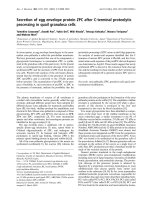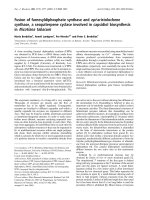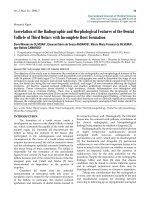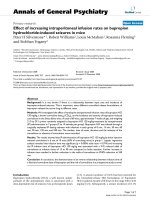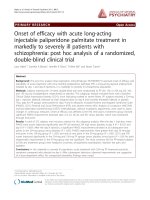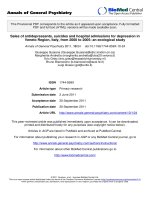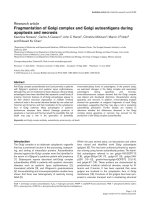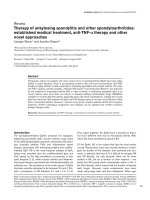Báo cáo y học: "Perceptions of environmental changes and Lethargic Crab Disease among crab harvesters in a Brazilian coastal community" ppt
Bạn đang xem bản rút gọn của tài liệu. Xem và tải ngay bản đầy đủ của tài liệu tại đây (4.51 MB, 29 trang )
This Provisional PDF corresponds to the article as it appeared upon acceptance. Fully formatted
PDF and full text (HTML) versions will be made available soon.
Perceptions of environmental changes and Lethargic Crab Disease among crab
harvesters in a Brazilian coastal community
Journal of Ethnobiology and Ethnomedicine 2011, 7:34 doi:10.1186/1746-4269-7-34
Angelica MS Firmo ()
Monica MP Tognella ()
Walter LO Co ()
Raynner RD Barboza ()
Romulo RN Alves ()
ISSN 1746-4269
Article type Research
Submission date 1 July 2011
Acceptance date 16 November 2011
Publication date 16 November 2011
Article URL />This peer-reviewed article was published immediately upon acceptance. It can be downloaded,
printed and distributed freely for any purposes (see copyright notice below).
Articles in Journal of Ethnobiology and Ethnomedicine are listed in PubMed and archived at PubMed
Central.
For information about publishing your research in Journal of Ethnobiology and Ethnomedicine or any
BioMed Central journal, go to
/>For information about other BioMed Central publications go to
/>Journal of Ethnobiology and
Ethnomedicine
© 2011 Firmo et al. ; licensee BioMed Central Ltd.
This is an open access article distributed under the terms of the Creative Commons Attribution License ( />which permits unrestricted use, distribution, and reproduction in any medium, provided the original work is properly cited.
1
Perceptions of environmental changes and Lethargic Crab Disease among crab
harvesters in a Brazilian coastal community
Angélica MS Firmo
1*
, Mônica MP Tognella
1
, Walter LO Có
2
, Raynner RD Barboza
3
,
Rômulo RN Alves
3
1
Departamento de Ciências Agrárias e Biológicas, Programa de Pós Graduação em
Biodiversidade Tropical (Ecologia), Universidade Federal do Espírito Santo – UFES,
São Mateus, Brazil;
2
Departamento de Biologia, Associação Educacional de Vitória –
AEV, Vitória, Brazil;
3
Departamento de Biologia, Programa de Pós-Graduação em
Ciências Biológicas (Zoologia) Universidade Estadual da Paraíba – UEPB, Paraíba,
Brazil.
E-mail adresses:
Angélica MS Firmo:
Mônica MP Tognella:
Walter LO Có:
Raynner RD Barboza:
Rômulo RN Alves:
Corresponding author
Angélica Maria Scaldaferri Firmo. Departamento de Ciências Agrárias e Biológicas,
Universidade Federal do Espírito Santo, Centro Universitário Norte do Espírito Santo,
UFES/CEUNES. São Mateus, Espírito Santo, Brazil. ZIP Code: 29932-540.
Telephone/fax: +55 27 33121563. E-mail:
2
Abstract
Background
Lethargic Crab Disease (LCD) has caused significant mortalities in the population of
Ucides cordatus crabs in the Mucuri estuary in Bahia State, Brazil, and has brought
social and economic problems to many crab-harvesting communities that depend on this
natural resource. The present work examined the perceptions of members of a Brazilian
crab harvesting community concerning environmental changes and the Lethargic Crab
Disease.
Methods
Field work was undertaken during the period between January and April / 2009, with
weekly or biweekly field excursions during which open and semi-structured interviews
were held with local residents in the municipality of Mucuri, Bahia State, Brazil. A total
of 23 individuals were interviewed, all of whom had at least 20 years of crab-collecting
experience in the study region. Key-informants (more experienced crab harvesters) were
selected among the interviewees using the “native specialist" criterion.
Results
According to the collectors, LCD reached the Mucuri mangroves between 2004 and
2005, decimating almost all crab population in the area, and in 2007, 2008 and 2009
high mortalities of U. cordatus were again observed as a result of recurrences of this
disease in the region. In addition to LCD, crabs were also suffering great stock
reductions due to habitat degradation caused by deforestation, landfills, sewage
effluents, domestic and industrial wastes and the introduction of exotic fish in the
Mucuri River estuary. The harvesting community was found to have significant
ecological knowledge about the functioning of mangrove swamp ecology, the biology
3
of crabs, and the mass mortality that directly affected the economy of this community,
and this information was largely in accordance with scientific knowledge.
Conclusions
The study of traditional knowledge makes it possible to better understand human
interactions with the environment and aids in the elaboration of appropriate strategies
for natural resource conservation.
Keywords
Crab harvesters, mangrove, ecological knowledge, Lethargic Crab Disease.
Background
Mangrove forests are highly productive ecosystems found along the coast of Brazil that
provide valuable resources such as timber, medicinal products, natural dyes, fish,
crustaceans, and mollusks, as well as environmental services [1- 6]. Brachyura crabs are
a major economic resource for the coastal dwellers of northeastern Brazil, as either
subsistence economic items or for direct consumption. The main species
commercialized are blue land crabs (Cardisoma guanhumi (Latreille, 1825), callinectes
crabs (Callinectes spp.), and mangrove land crabs (Ucides cordatus Linnaeus, 1763).
The mangrove land crab is the most heavily harvested species, and therefore of
particular relevance to people living in the surrounding mangrove areas [7].
Ucides cordatus inhabits in individual burrows about 120 cm deep that are dug under
mangrove trees [8]. Studies undertaken in northern Brazil have determined that adult
mangrove crabs have few natural predators, but these included the crab-eating raccoon
(Procyon cancrivorous (Cuvier, 1798), monkeys, and hawks [9]. High predation
pressure is exerted on U. cordatus by humans, however, who harvest this species for
direct consumption [10] and principally for commercialization. The harvesting of U.
cordatus has significant socioeconomic importance in northeastern Brazil and involves
4
many local residents who benefit both directly and indirectly from commerce involving
this species [7, 11].
Massive mortalities of U. cordatus have been reported by crab harvesters and biologists
since 1997 throughout northeastern Brazil, from Ceará to Espírito Santo State [12,13]
that have decimated local stocks (reaching 84% reductions, according to interviews with
crab-harvesters) [7]. This mortality has generated considerable concern among
specialists in regards to resulting environmental and socioeconomic impacts [7].
Many investigations were undertaken to determine the causative agent of this mass
mortality, until Boeger et al [12] conclude that the causative agent as an Exophiala
species of fungus. This disease, which is specific to the crab species Ucides cordatus, is
the first known disease caused by a fungus in crustaceans [14]. Due to the fact that
numerous symptoms were shared by many crabs in areas with high mortality rates, such
as lethargy, deficient motor control, and an incapacity to return to an upright position,
this disease was given the name Lethargic Crab Disease (LCD) [15].
Decreases in crustacean populations have created social problems in the communities
surroundings mangrove areas and seriously affected the economic welfare of the poor
people who depended upon crab harvesting for their livelihood. The life of crab
harvesters is intimately linked to ecological processes and cycles, and their daily work
with other natural resources has helped them develop harvesting strategies that
maximize their crab harvesting efficiency. The understanding these local residents have
of the ecology of U. cordatus is an important factor in the use of this natural resource
[11, 16], and the present research sought to characterize the traditional knowledge of
these crab harvesters regarding environmental changes in the mangrove forests of the
Mucuri River estuary, Bahia State, in northeastern Brazil and regarding Lethargic Crab
Disease in the same region.
5
Methods
Study area
The present research was carried out in the mangrove estuary of Mucuri River located in
the municipality of Mucuri, Bahia State, in northeastern Brazil (17
o
51’00” - 18
o
05’17”
S and 39
o
33’14”- 40
o
00” W) (Figure 1). The entire area of influence of the Mucuri
River is contained within the Costa Dourada Permanent Protection Area, under control
of the Brazilian Institute for the Environment and Natural Resources - IBAMA (Figure
2). The estuary contains large extensions of mangrove forests, islands, and islets (these
latter formed by sandy-clay-loam banks). The most common trees found in the
mangrove forests are Rhizophora mangle, Avicennia germinans, Avicennia schaueriana,
and Laguncularia racemosa [17].
Data collection and analyses
Our research was undertaken between January and April/2009, with weekly or biweekly
field excursions. A community meeting was held with crab harvesters before initiating
the actual fieldwork to inform them about the aims of our study, our research methods,
and to solicit their participation in the investigations. Qualitative methods were used to
obtain information about environmental changes that have occurred in the mangrove
forest, crab harvesting, and the local perception of Lethargic Crab Disease. We did not
adopt a formal approach using interview consent forms, due to the poor level of
organization within the fishing community and the high illiteracy rate.
Open and semi-structured interviews were conducted with 23 people, and additional
interviewees were chosen by using the "snowball technique" [18, 19], based on
information provided by local specialists. Interviews were conducted on a one-on-one
basis. Key-informants (more experienced crab harvesters) were selected from among
the interviewees using the criterion of "native specialists" – people who consider
6
themselves, and are considered by the community, as culturally competent in this area
[20, 21].
All of the interviewees harvested crabs as their main economic activity (active or
retired) and had at least 20 years of experience in the study region. Each collector was
interviewed individually, time limit for the interviews (which generally lasted between
1 and 3 hours each). Interviews consisted of asking crab harvesters about two subjects:
A) to describe the community’s perception of its relationship to the mangrove forests (to
determine their views of the degradation and conservation of the mangrove forests and
the management of natural resources); B) to describe the community’s perception of the
Lethargic Crab Disease and the socioeconomic problems resulting from it. These
questions were presented to the crab harvesters using a standardized questionnaire with
16 questions; the details of the interviews were recorded manually and/or by using a
voice recorder. The transcriptions were made with a full awareness of the need to be
faithful to the interviewees manner of expression.
The interviews were always preceded by the interviewer's identification with a brief
explanation about the purpose of work and an informed consent and permission for
publication of the images were given by those interviewed. Other techniques used
included direct observations (accompanying the crab harvesters individually during
their daily activities) and "guided tours" – two integrate the researchers and
interviewees and to experience their routine activities in their natural environment.
In addition to the interviews with the crab harvesters, an ethno-mapping of the Mucuri
River estuary mangrove forests was undertaken using aerial photographs and maps
instead of illustrations and drawings made by the crab harvesters. This mapping
examined the perceptions of local informants concerning the locations of local natural
resources [22], as we asked them to identify the different areas of the mangrove forests
7
(and to correctly name them) and to indicate which areas were most affected by the crab
disease and the most vulnerable environments.
Results
Perceptions of environmental changes
When asked about their relationships with the mangrove forests, the interviewees
reported being directly linked with those environments and they considered the estuary
to be one of the most important features in their lives – especially since their economic
survival was almost completely dependent on crab harvesting. Nineteen of the
interviewees reported that they appreciated (were proud of) their profession as crab
harvesters and that they intended to continue in that occupation. All of them, however,
reported that the mass mortality that had decimated the crab stocks in the Mucuri River
estuary was making it almost impossible to continue in their profession. Many crab
harvesters were very unhappy with the situation and doubted their ability to continue
working there if the land crab stocks were not restored.
When asked about how to best protect the mangrove forests and the mangrove land
crabs, the interviewees gave different responses. Some replied that they would like to
act as monitors to prohibit capture during the reproductive period, while others stated
that people should stop destroying the mangrove forests and restore the environment,
and avoid polluting the river estuary. All of the crab harvesters appeal for financial
support from the government so that they could afford to stop gathering crabs during
their reproductive and ecdysis periods. Financial support is in fact provided to
fishermen and crab harvesters in Brazil during the animals’ reproductive periods;
however, the crab harvesters in this particular municipality do not have any registered
association so they cannot receive any financial support.
8
All of the interviewees affirmed that before the appearance of the disease they were
only authorized to capture Ucides cordatus more than 6.0 cm. In Brazil, harvesting
mangrove land crab is regulated by Normative Instruction n° 34 of March 24, 2003
issued by the Instituto Brasileiro do Meio Ambiente e dos Recursos Naturais
Renováveis (IBAMA), which prohibits taking female crabs during the period between
December 1 and May 31, or capturing males or females less than 6.0 cm long.
The interviewees reported that they were able to distinguish males from females by their
tracks at the burrow entrances. The fishermen call the female crabs ‘candurua’ (a
corruption of the word for ‘female kangaroo’ in informal Brazilian Portuguese) because
they carry their egg masses on their abdomens. The females do not have any hair on
their legs and leave deep thin tracks at the burrow entrances; the hairy legs of males
leave relatively wide and shallow tracks (Figure 3).
All of the interviewees reported that harvesting mangrove land crabs was their only (or
principal) economic activity. Only one interviewee reported harvesting blue land crabs
(Cardisoma guanhumi) as well as mangrove land crab, and two crab harvesters were
also fishermen.
Among the interviewees, 21said that they did not have any other economic activity
besides crab gathering. When asked about the collection techniques they used for
capturing mangrove land crabs, all of the interviewees claimed to use the manual
collection technique. This technique requires putting one's entire arm into the burrow
and grabbing the animal by the dorsal portion of its carapace (Figure 4) and then pulling
it out in a lateral position. Only one interviewee reported using a curved iron tool to pull
the crab from its burrow.
There is another technique called “redinha” used in crab harvesting that employs in
amorphous mass of thin plastic mesh that is placed at the mouth of the burrow to
9
entangle the crabs and facilitate their capture. This technique is considered predatory
(and illegal) by the crab harvesters because it indiscriminately traps adults and
juveniles, males and ovigerous females; these snares are often lost and can cause the
death of other crabs as they pollute the mangrove area.
Consequently, crab harvesters are well aware of the use of “redinhas” in the region,
although none of the interviewees claimed to use them. When asked about the best
period for collecting crabs all of the interviewees indicated that the summer and
reproductive season were best (between December and March). The crabs all leave their
burrows during this period to copulate and are easily captured as they lose their
defensive and directional instincts.
All of the interviewees also felt that the exotic fish being farmed in the Mucuri River
estuary (e.g. Tucunaré peacock bass (Cichla sp.) and the African sharpthooth catfish
(Clarias gariepinus) were related to the decreases in crab populations. The crab
harvesters said that these fish were introduced into ponds along the Mucuri River and
that they often escape to the estuary during floods, where they feed on crab larvae, thus
diminishing crab populations.
Perceptions of Lethargic Crab Disease
When asked about diseases that could be causing massive crap die offs, the interviewees
all confirmed that they knew about the disease currently affecting the crustacean. They
stated that there is currently a mortality rate of approximately 50% when compared to
the period just prior to the arrival of the disease. Interestingly, none of the crab
harvesters knew the official name of this disease.
According to most of the interviewees (about 70%), the disease first appeared in the
Mucuri River estuary between September and October/2004 and resulted in very high
mortality rates in 2005, and all of the crab harvesters said that the disease was still
10
affecting the area. This was confirmed by the authors during the field work phase of this
project, as many did mangrove land crabs were found, while others presented clinical
signs of LCD. The crab harvesters reported that only small and young crabs could be
found in the area. They also stated that there were large die offs of U. cordatus in 2007,
2008 and 2009 as a result of recurrences of this disease in the region.
According to the interviewees, there are periods with high mortality rates and others in
which the disease relents a bit and crab populations increase.
Regarding the clinical signs noted by the crab harvesters, all of them cited lethargy,
differences in colors and textures of the internal organs in infected individuals, and the
presence of foam coming from the crustacean’s mouth region. According to the crab
harvesters, animals contaminated by LCD appear "dirty", which is notable, for even
though they live in the mud the crustaceans always appear groomed and clean; the crabs
also lose their reflexes and will remain still with their eyes and claws drooping (Figure
5). An interesting phenomenon reported by all of the interviewees was that the disease
leads to changes in the behavior of the mangrove land crabs, and they show exaggerated
defensive behaviors, staying inside their burrows for long periods of time and covering
their tunnels even though they were not undergoing ecdysis. When asked to identify the
areas of the Mucuri River estuary that were most affected by the disease and that had
the highest mortality rates, the interviewees indicated the areas closest to a paper factory
that was discharging its wastes in the river (Figure 6).
The major (or only) economic resource of many local families is provided by crab
harvesting, and since these people did not receive any assistance that could minimize
the economic shock resulting from the scarcity of crabs, significant socioeconomic
impacts were felt. Many crab harvesters were unhappy with their current situation and
indicated that they would consider abandoning the profession if the stocks of mangrove
11
land crabs did not rebound. Another problem that arose after the appearance of LCD
was the noncompliance with environmental laws that regulate crab harvesting activities.
The fishermen pointed out that it was no longer possible to find crabs larger than the
legal limit of 6.0 cm; they also noted that it was impossible to respect the reproductive
season of the crab (when the animals were more available).
Many crab harvesters reported that previously to the outbreak of the disease they could
harvest between 75 and 100 crabs in a single day, but this number was drastically
reduced to 25 crabs a day with the appearance of LCD. The crab harvesters are well
aware that this situation may lead to even greater decreases in crab populations, but they
cite their need to survive.
Discussion
In terms of the relationships of crab harvesters with the mangrove swamp, we were able
to diagnose a direct link between the estuary and the survival of the local human
populations. This relationship was very evident in the present study, as it had been in
other previous field investigations [7, 23, 24]. Most of the crab harvesters built their
lives around coastal areas, estuaries and mangroves, and the knowledge passed to them
by their ancestors, together with their own experiences, helped them to work and
survive in mangrove swamps and to be recognized as members of a traditional
population. Diegues [25] noted that knowledge about the cycles and dynamics of nature
that have been passed down from generation to generation represent one of the principal
components that characterize the traditional communities and allows these people to
develop and use effective resource management strategies.
We noted in this study that crab harvesters differentiate between male and female
mangrove land crabs. This finding was similar to that of other authors [26] who studied
environmental perceptions among crab harvesters in Paraiba State in northeastern Brazil
12
– which suggests that this information is endemic to traditional coastal communities
throughout the country. This type of information is very important in terms of the
conservation of mangrove land crabs, as this species is subjected to high predation
pressure rates and the harvesting of females is pivotal to maintaining viable crab
populations. If this behavior were recognized and encouraged, the fishermen would
become partners to state and federal agencies in public conservation policies.
Regional studies should be undertaken to better orient governmental institutions in
adopting conservation programs and regulations. This type of orientation could be very
important as only mature males can currently be captured – and this will alter the
proportions of males and females and leads to sexually unbalanced populations.
Accordingly, studies focused on separate regions could examine male and female
captures in different portions to determine optimal management and conservation
techniques for this crustacean.
Regarding the local knowledge of the LCD disease affecting U. cordatus, most
interviewees reported being aware of this disease, although none of them could name it.
Interestingly, while the interviewees could not name the disease that was infecting the
crabs in the region, all of them could identify the major clinical symptoms of LCD. This
inability to correctly name the disease is almost certainly due to the fact that it was only
recognized and named by Boeger et al [15] (in reference to the lethargy demonstrated
by infected crustaceans). These authors provided robust evidence suggesting that LCD
is caused by an anamorph fungus and phylogenetic analyses have confirmed the
diagnosis of the LCD fungus as an ascomycete (fungus of the phylum Ascomycota),
and they suggest a close relationship with members of the subphylum Pezizomycotina .
Direct cultures of tissue from sick crabs, and subsequent isolation and purification, have
identified the causative agent as an Exophiala species of fungus that affects the tissues
13
and/or the hemal lacunae of the epidermis, connective tissue, hepatopancreas, heart,
thoracic ganglion and associated nerve fibers, gills, and intestines [12]. Orélis-Ribeiro et
al [27], fulfilling the rigorous Koch postulates, concluded that the Exophiala cancerae
species is the causative agent of LCD. His results support that the fungal agent is
pathogenic and upheld the hypothesis of Boeger et al [12,15] that associated this fungus
with LCD and the mass die offs of crabs.
High rates of crab mortality were first noted in Brazil in 1997 and precipitated profound
alterations in coastal communities that depended on this crustacean resource [7]. The
mangrove swamps in the states of Bahia and Pernambuco suffered reductions of 84%
and 97.6% in their U. cordatus stocks respectively. These reductions were directly
associated with the massive die offs that seriously affected local fishing communities
and led to social and economic problems in the region. In addition to LCD, crab stocks
are also being impacted by habitat degradation as mangrove areas forests are subjected
to deforestation and detrimental activities such as carciniculture and waste and garbage
disposal [28]. This view is reinforced by other authors [7] who reported that U. cordatus
harvesters in northeastern Brazil associated the occurrence of LCD with pesticide use in
sugar cane plantations near mangrove forests. But there is still considerable uncertainty
surrounding the origin and dissemination of this disease.
According to a report published by the Goiamun Institute [29, 30], technical visits/field
studies were undertaken in mangrove forests in the municipalities of Nova Viçosa and
Mucuri (Bahia State, Brazil) to follow the evolution of this disease and the massive die
offs of mangrove land crabs. This report indicated that no burrows of adult or sub-adult
crabs could be found, leading to the conclusion that crabs in these age classes were
heavily affected. These results are in agreement with the observations of the
interviewees in the present study, as they only reported encountering small crabs,
14
probably young ones. Schmidt [30] study the effects of one LCD event on U. cordatus
in southern Bahia, and observed that most of the crabs left their burrows before dying
and that individuals of all size classes were affected, although the larger animals,
occupying zones that were more heavily flooded, appeared to be most affected by the
mass die offs – and the greatest reductions in population density occurred in zones
occupied by the mangrove tree Rhizophora mangle, indicating that the causative agent
was in some way associated with water.
These observations lead us to presume a greater vulnerability of adult crabs to this
disease, or that some aspect of the infectious chain is more relevant in adult crustaceans.
Mangrove land crab populations do not disappear completely, leading scientists to
conclude that some individuals are naturally resistant to the disease. Researchers
likewise observed that other crab species (such as Goniopsis sp., Uca spp., and the blue
land crab Cardisoma guanhumi) were not affected by the disease. As most of the
interviewees only harvested U. cordatus, we could not confirm this particular aspect of
the disease.
The defensive behavior of crabs presenting clinical signs of LCD was highlighted by all
of the interviewees. This behavioral change was characterized by the animals covering
their burrows and staying in them for long periods of time. This behavior was also
reported by Schmidt [30], who reported massive mortality rates in U. cordatus
populations in the mangrove forests of Caravelas, Bahia State, Brazil. Based on these
observations, it is possible to conclude that these behavioral changes are associated with
avoidance of exposure to predators, as the crabs are much more vulnerable when
manifesting clinical signs of LCD.
Many crab harvesters reported environmental changes associated with the introduction
of exotic animal species into the estuary, and exotic fish species are known to affect the
15
structure and functioning of aquatic environments [31]. The introduction of exotic fish
species can cause many ecological changes affecting biodiversity through biological
mechanisms such as hybridization and disease [32] and could, in this particular case,
have contributed to crab mortality.
When asked which areas of the Mucuri River estuary mangrove forests were most
affected by the disease and presented the highest crab mortality rates, the interviewees
indicated sites close to the effluent pipes of a paper factory – leading the crab harvesters
to associate the death of the crustaceans with the discharged waste. We must stress,
however, that this is the point of view of the crab harvesters, and the direct cause of the
disease affecting the Mucuri River estuary mangrove land crabs has yet to be fully
determined.
Traditional knowledge can be critical to establishing sound policies regulating the
sustainable exploitation of natural resources [7, 11]. Brazilian governmental offices
responsible for environmental monitoring and for controlling U. cordatus harvesting
have not made a practice of considering local ecological knowledge – which could
explain the generally low effectiveness of their policies [33]. The perceptions of local
populations can and should be used in formulating the policies of regulatory agencies.
The contributions of these communities are essential to the sustainable management of
local resources, and need to be incorporated into decision making processes.
Conclusions
Additional ethnoecology and ethnobiology studies of Ucides cordatus are needed, for
the folk knowledge retained by traditional communities concerning the natural resources
they come into contact with on a daily basis can benefit efforts to conserve and preserve
regional biodiversity [7, 11, 21, 24, 25, 33-42].
16
U. cordatus gatherers have developed an intimate knowledge of the natural history of
this species. The unique nature of this local knowledge demonstrates the need for
considering input from these populations in the implementation of management plans of
coastal mangrove ecosystems, and for understanding local crab stocks and their
population dynamics. This kind of information can be used for establishing extractive
reserves, for delimiting the harvest season, and for establishing protected areas where
animal species can safely reproduce and maintain their stocks.
It has become evident that efforts directed towards the preservation of native species
should employ gradual and integrated approaches, coupled with monitoring of the
communities involved, and these communities must be inserted into programs of
environmental education and social assistance.
Competing Interests
The authors declare that they have no competing interests.
Authors' contributions
AMSF - Writing of the manuscript, literature survey and interpretation; AMSF, MMPT,
WLOC, RRDB and RRNA - Ethnozoological data, literature survey and interpretation;
AMSF and MMPT - Analysis of taxonomic aspects. All authors read and approved the
final manuscript.
Acknowledgements
We wish to thank Fernando Firmo and Valéria Scaldaferri for their help on handling
with the local crab collectors and for their guided tours within the mangrove forests of
Mucuri River. We are also grateful to Breno Salgado and Roy Funch for translating this
work into English.
References
17
1. Rocha MSP, Mourão JS, Souto MSW, Barboza RRD; Alves, RRN: O Uso dos
Recursos Pesqueiros no Estuário do Rio Mamanguape, Estado da Paraíba,
Brasil. Interciencia 2008, 33:903-909.
2. Nishida AK, Nordi N, Alves RRN: Mollusk Gathers of Northeast Brazil:
Gathering Techniques and Productivity. Human Ecology 2006, 34:133-145.
3. Nishida AK, Nordi N, Alves RRN: The lunar-tide cycle viewed by crustacean
and mollusc gatherers in the State of Paraiba, Northeast Brazil and their
influence in collection attitudes. Journal of Ethnobiology and Ethnomedicine
2006, 2:1-12.
4. Nishida AK, Nordi N, Alves RRN: Molluscs production associated to lunar-
tide cycle: a case study in Paraíba State. Journal of Ethnobiology and
Ethnomedicine 2:1-6.
5. Rosa IL, Alves RRN, Bonifacio KM, Mourão JS, Osorio FM, Oliveira TPR,
Nottingham MC: Fishers' knowledge and seahorse conservation in Brazil.
Journal of Ethnobiology and Ethnomedicine 2005, 1:1-15.
6. Walters BB, Rönnbäck P, Kovacs JM, Crona B, Hussain SA,,Badola B,
Jurgenne HP, Barbier E, Dahdouh-Guebas F: Ethnobiology, socio-economics
and management of mangrove forests: a review. Aquatic Botany 2008, 89:
220–236.
7. Alves RRN, Nishida AK: Aspectos socioeconômicos e formas de percepção
ambiental dos catadores de caranguejo-uçá Ucides cordatus cordatus (L.
1763) (Decapoda, Brachyura) do estuário do rio Mamanguape. Interciencia
2003, 28:36-43.
18
8. Branco JO: Aspectos bioecológicos do caranguejo Ucides cordatus (Linnaeus,
1763) (Crustacea: Decapoda) do manguezal de Itacorubi, Santa Catarina,
Brasil. Arquivos de Biologia e Tecnologia 1993, 36:133-148.
9. Koch V. Epibenthic production and energy flow in the Caeté mangrove
estuary, North Brazil. PhD thesis. Bremen University; 1999.
10. Diele K. Life history and population structure of the exploited mangrove
crab Ucides cordatus (L.) (Decapoda:Brachyura) in the Caeté estuary, North
Brazil. PhD thesis. Bremen University; 2000.
11. Alves RRN, Nishida AK: A ecdise do caranguejo-uçá, Ucides cordatus
(Crustacea, Decapoda, Brachyura) na visão dos caranguejeiros. Interciencia
2002, 27:110-117.
12. Boeger WA, Pie MR, Vicente V, Ostrensky A, Hungria D, Castilho GG:
Histopathology of the mangrove land crab Ucides cordatus (Ocypodidae)
affected by lethargic crab disease. Diseases of Aquatic Organisms 2007,
78:73-81.
13. Ribeiro RO: Doença do Caranguejo Letárgico: Desvendando questões
etiológicas, epidemiológicas e de Saúde Pública. Curitiba. Dissertação
Mestrado. Universidade Federal do Paraná, Centro de Ciências Biológicas e da
Saúde, Programa de Pós-graduação em Ciências Biológicas (Microbiologia,
Parasitologia e Patologia Básica); 2008.
14. Boeger WA, Pie MR: Montando o quebra cabeça. Revista do GIA 2006, 1:34–
36
15. Boeger WA, Pie MR, Ostrensky A, Patella L: Lethargic crab disease:
multidisciplinary evidence supports a mycotic etiology. Memórias do
Instituto Oswaldo Cruz 2005, 100:161-167.
19
16. Maneschy MC: Ajuruteua, uma comunidade pesqueira ameaçada. UFPA
University Press, Belém, Brazil; 1995
17. CEPEMAR: Monitoramento do Manguezal de Mucuri / BA: Technical
Report Press. Vitória, Brazil; 1998.
18. Bailey KD: Typologies and Taxonomies: An Introduction to Classification
Techniques. Journal of the American Society for Information Science 1996,
47:328-329
19. Bailey KD: Methods of social research. 4th edition. New York: The Free Press.
1982.
20. Hays TE: An Empirical Method for the Identification of Covert Categories
in Ethnobiology. American Ethnologist 1976, 3:489-507.
21. Marques JGW: Pescando Pescadores: etnoecologia abrangente no baixo São
Francisco Alagoano. NUPAUB São Paulo Press; 1995.
22. Boissiere M, Basuki I, Koponen P, Wan M, Sheil D: Biodiversity and local
perceptions on the edge of a conservation area, Khe Tran Village, Vietnam.
Center for International Forestry Research (CIFOR) Press; 2006.
23. Marques JGW: A fauna medicinal dos índios Kuna de San Blas (Panamá) e a
hipótese da universalidade zooterápica [abstract]. Anais da 46a Reunião
Anual da SBPC 1994:324.
24. Nordi N, Nishida AK, Alves RRN: Effectiveness of Two Gathering
Techniques for Ucides cordatus in Northeast Brazil: Implications for the
Sustainability of Mangrove Ecosystems. Human Ecology 2009, 37:121-127.
25. Diegues ACS: O Mito Moderno da Natureza Intocada. Hicitec São Paulo Press;
1998.
20
26. Alves RRN, Nishida AK, Hernandez MIM: Environmental perception of
gatherers of the crab ‘caranguejo-ucá’ (Ucides cordatus, Decapoda,
Brachyura) affecting their collection attitudes. Journal of Ethnobiology and
Ethnomedicine 2005, 1:10.
27. Orélis-Ribeiro R, Boeger WA, Vicente VA, Chammas M, Ostrensky A:
Fulfilling Koch’s postulates confirms the mycotic origin of Lethargic Crab
Disease. Antonie Van Leeuwenhoek 2011, 99:601-608.
28. Ecotuba. Plano de ação para o caranguejo uçá em Canavieiras. Canavieiras
Press, Brazil. 2006.
29. Vieira JC: Laudo técnico pericial sobre a mortandade de caranguejo uçá em
Nova Viçosa e Mucuri/BA. Instituto de Desenvolvimento Humano e Ambiental
– Goiamum, 2005, in press.
30. Schmidt AJ: Estudo da dinâmica populacional do caranguejo-uçá, Ucides
cordatus cordatus (Linnaeus, 1763) (Crustacea-Decapoda-Brachyura) e dos
efeitos de uma mortalidade em massa desta espécie em manguezais do Sul
da Bahia. Dissertação Mestrado. Instituto Oceanográfico da Universidade de
São Paulo, Centro de Oceanografia Biológica; 2008.
31. Lodge DM: Biological invasions: lessons for ecology. Trends in Ecology &
Evolution 1993, 8:133-137.
32. Mack RN, Simberloff DD, Lonsdale WM, Evans H, Clout MN, Bazzazz F:
Biotic invasions: causes, epidemiology, global consequences and control.
Issues in Ecology 2000. 5:1-20.
33. Nordi N: O processo de comercialização do caranguejo-uçá (Ucides cordatus)
e seus reflexos nas atividades de coleta. Revista Nordestina de Biologia 1995,
10:39-45.
21
34. Nordi N. A captura do caranguejo-uçá (Ucides cordatus) durante o evento
reprodutivo da espécie: o ponto de vista dos caranguejeiros. Revista
Nordestina de Biologia 1994, 9:41-47.
35. Nordi N: Time allocation and energy expenditure related to crab gathering
activity. Ciência e Cultura 1997, 49:136-139.
36. Alves AG, Souza RM: Etnoecologia de um ambiente estaurino no nordeste
do Brasil: Conhecimento dos “mariscos” (Mollusca:Bivalvia) por mulheres
no Canal de Santa Cruz [abstract]. Anais do MANGROVE, 2000:85
37. Rodrigues AMT, Branco EJ, Saccardo AS, Blankensteyn, A: A explotação do
caranguejo Ucides cordatus (Decapoda: Ocypodidae) e o processo de gestão
participativa para normatização da atividade na região Sudeste- Sul do
Brasil. Boletim do Instituto de Pesca 2000, 26:63-78.
38. Passos CA, Di Beneditto APM: Captura comercial do caranguejo-uçá, Ucides
cordatus (L., 1763), no Manguezal de Gargaú, RJ. Biotemas 2005, 18:223-
231.
39. Costa-Neto EM: Implications and applications of folk zootherapy in the
State of Bahia, Northeastern Brazil. Sustainable Development 2004, 12:161-
174.
40. Machado D: Catadoras de caranguejo e saberes tradicionais na conservação
de manguezais da Amazônia brasileira. Estudos Feministas 2007, 15:485-490.
41. Mendonça JT, Pereira ALC: Avaliação das capturas de caranguejo-uçá
Ucides cordatus no município de Iguape, litoral sul de São Paulo, Brasil.
Boletim do Instituto de Pesca 2009, 35:169-179.
22
42. Carvalho HRL, Igarashi MA: A utilização do forjo na captura do caranguejo
uçá (Ucides cordatus) na comunidade de Tapebas em Fortaleza – CE.
Biotemas 2009, 22:69-74.
Figure legends
Figure 1 Map of the Mucuri River estuary, Bahia state, Brazil.
Figure 2 Aerial view of Mucuri River estuary and the municipality of Mucuri.
Figure 3 Collector showing the size and sexual dimorphism of the land crab species
(Ucides cordatus).
Figure 4 Crab collector demonstrating an arm collection technique: the gatherers put
their entire arms in the mud in order to catch the crab of their burrows.
Figure 5 Ucides cordatus specimen captured probably presenting the signs of LCD
disease.
Figure 6 Crab collector showing the internal organ of a dead crab presumably by
lethargic crab disease.
Figure 1
Figure 2


